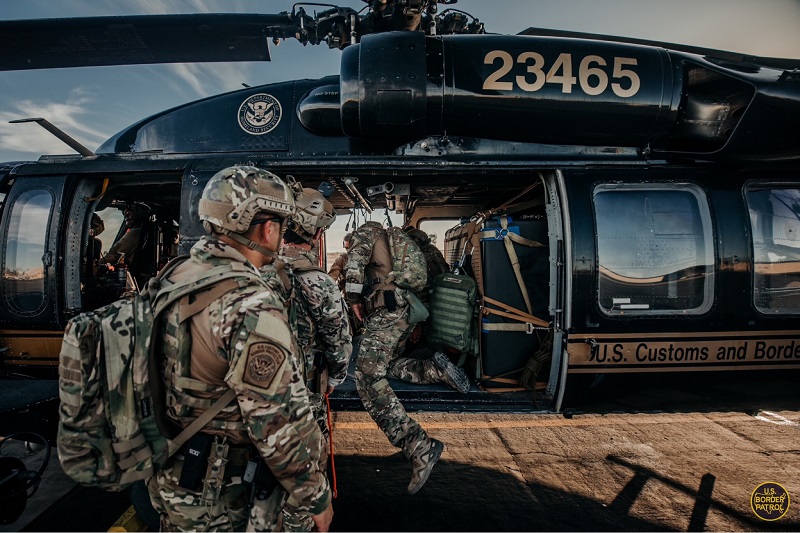
As the natural disaster on the island of Maui, Hawaii, sees the death toll uptick, U.S. Border Patrol agents put boots on the ground to search for many missing individuals while also catering humanitarian aid to survivors hard-pressed for basic sustenance.
As the Maui wildfires news broke and hit the airwaves, the Border Patrol went airborne in their helicopters, occupied by superiorly trained special operations agents assigned to their elite units.
The U.S. Border Patrol “not only secures our nation’s borders, [but] we also provide vital responses to natural disasters. SOG Operators from our BORSTAR & BORTAC teams are on the ground in Maui assisting with search & rescue and providing critical humanitarian aid. We are with you, Hawaii.”
BORSTAR
The US Customs and Border Protection’s BORSTAR (Border Patrol Search, Trauma, and Rescue) specialists are headquartered in El Paso, Texas. The elite unit was created in 1998, stemming from a “growing number of injuries to Border Patrol agents and migrant deaths along our nation’s borders.”
This robustly trained unit is ideal for the challenges at hand on Maui, having perfected their skills and delivery methods over a quarter century…
“BORSTAR is the only national law enforcement search and rescue entity with the capability to conduct tactical medical, search and rescue training for Federal, state, local, and international government agencies” and invites prospective unit members from all regions where the Border Patrol has a footprint, culling agents for testing at their Selection and Training Course (STC), where candidates undergo a battery of physical and mental health challenges of assorted “search and rescue techniques, tactical medicine, technical rescue, land navigation, communication, swift-water rescue, air operations, and the ability to work in a cohesive unit.”

(Photo courtesy of Border Patrol Agent Vincent Vargas.)
Whew! One may feel dehydrated just reading all those requisite attributes to make the grade. But there is more, much more…
Once chosen for BORSTAR operations, Border Patrol agents receive more specialized training in operations management and planning, personnel recovery, tactical medicine, paramedic principles, cold-weather operations, emergency medicine, rescue watercraft operations, small unit tactics, tactical combat casualty care, austere medic applications, helicopter rope suspension training, load planning, and advanced dive, swift-water, and technical rope operations.
Seems these men and women are equipped to leave no stone unturned and are able-bodied to mitigate just about any dynamic they confront, hence their presence on Maui, specifically in and around the historic town of Lahaina, now largely charred and decimated.
Maui County Water Department heads have been issuing News Flashes, warning people against consuming water supplies, citing contaminants and such. Like they did thereafter Hurricane Maria’s devastation of Puerto Rico, with the island’s water supply decimated, teams of Border Patrol agents flew helicopters loaded with cases of bottled drinking water.

(Photo courtesy of U.S. Customs and Border Protection.)
Among other sustenance, this is being repeated with Maui’s situation.
BORTAC
Similarly, the Customs and Border Protection BORTAC (Border Patrol Tactical Unit) is a contingent of agents who “deploy immediately when needed” and employ capabilities to “emergent and high-risk incidents requiring specialized skills and tactics.”
Also headquartered in El Paso, Texas, BORTAC was created in 1984 “to serve a civil disturbance function,” among other things such as reconnaissance, maritime operations, and airmobile operations.
BORTAC’s intense training regimen mimics aspects of our U.S. military’s Special Operations Forces, especially in the realms of prolonged treading water, swimming, and drown-proofing.
Those last three skillsets seem ideally suited for Maui’s mitigation…
Piggybacking on the “recovery” aspects implemented by BORSTAR operators, it would seem crucial to have BORTAC specialists handle the reports indicating that there are many missing persons.
Subsequent reports claimed many island inhabitants flocked to the waters of the Pacific to escape intense heat generated by widespread wildfires. Per the New York Post, one man was suffering second-degree burns “on his feet and nearly drowning when he took cover in the ocean with his girlfriend—who is now missing.”
“Like others, [Shawn] Doughtery said his only means of survival was to jump into the ocean with his girlfriend, but while some found safety in nearby jetties, the rocks and coral tore up Dougherty’s body.
“’At one point, it seemed like I might drown,’” he intimated to ABC News reporters. “I’m a good swimmer, but the water was just really rough because of the wind and the turbulence.”
As of this writing, Fox News reports “[…] death toll nears 100 as crews effort search and rescue and firefighters combat flare-ups in Maui.” Today, spokespeople for the Maui Police Department confirmed 96 fatalities so far. Also involved, primarily in waterborne search-and-rescue operations, are U.S. Coast Guard members stationed in Maui.
Given Mr. Doughtery’s descriptions, there are likely many more who sought refuge in the ocean, thus engendering first responders conducting waterborne rescues and body recoveries for who knows how long. Hence, the Border Patrol’s agents, highly skilled on land and in water, will have their work cut out for them and potentially come away with the ingredients that manifest PTSD proportions.
The same goes for local law enforcement officers with the Maui Police Department: “In the wake of this disaster, the Maui Police Department has been working tirelessly to coordinate a thorough and respectful body recovery operation within the affected area. Our primary objective is to ensure the proper handling and identification of deceased individuals while maintaining the safety of the community and public safety personnel on the scene.”
As Rogan O’Handley posted with footage: “Hawaiians ran for their lives and jumped into the ocean to get away from the fires and smoke. They’re still finding people’s bodies wash ashore who drowned or suffocated to death from the smoke. Where are all the politicians and celebs that visited Ukraine for their photo ops? Why aren’t they helping Hawaii?”
As always, first responders are there, wasting no time…implementing scores of training on behalf of people who have been subjected to a fierce catastrophe…